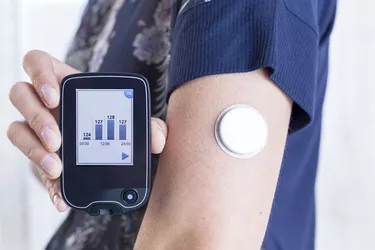
If you're one of the 34.2 million people living with diabetes, you likely realize the importance of keeping your glucose levels in check throughout the day. Traditionally, this was done with a finger prick, but if you use a continuous glucose monitor, you can enjoy 24/7 monitoring without needles.
However, if you struggle just to pay for your insulin, you might wonder if your insurance covers a CGM and, if not, is it worth paying out of pocket? This is a personal decision that you'll have to make after doing your research, speaking with your doctor and weighing the cost against the convenience and accuracy.
Video of the Day
Video of the Day
What Is a Continuous Glucose Monitor?
Once you've been diagnosed with diabetes, you'll have specific instructions from your medical provider that will include monitoring your glucose. A CGM monitors your glucose levels on a constant basis. For instance, the Dexcom takes a reading every five minutes and sends the reading to a receiver or your smartphone. It will also send alerts to a receiver or smartphone when issues like rapidly rising or falling glucose levels are detected.
How Does It Work?
The most accurate continuous glucose monitoring will come from a device with a sensor that is inserted beneath your skin. This communicates with a receiver and measures interstitial fluid in your blood to approximate the glucose level. Two widely used CGMs are made by Dexcom and Libre. Both CGMs have sensors with a thin filament that pierces the skin and measures the fluid beneath the skin. The Libre does this every minute. The Dexcom every five minutes. With the Libre, the reading is read by holding the phone over the sensor, With the Dexcom, the reading is transmitted to the receiver or smartphone. The Dexcom has a transmitter that generally lasts about six months. There is also a sensor that lasts for ten days. The Libre has a sensor with the necessary electronics for the reader eclosed. It lasts for 14 days.
There are multiple types of CGMs on the market today, so the specifics of each device may vary. Some CGMs also work with an insulin pump, so be sure to investigate this before you decide on a CGM if this is a factor for you.
Which One?
The best way to decide is to speak to your endocrinologist or diabetes care manager. They can help you decide if the alerts and Clarity software that come with the Dex are a better choice than the Libre for your personal situation. One important thing to note is that a CGM will greatly reduce the number of finger sticks, but there may still be times when you will need to use a standard glucose monitor and test strip. Also, the information captured by the system can be used to manage your diabetes, so speak to your doctor about what they use in their office and why.
Cost of a Glucose Monitor
All this technology can be expensive. And, using a CGM is not a one-time thing or investment. The sensors and the transmitter, if needed separately, must be replaced at regular intervals. The pricing varies, but you can get information about the current cost of the Libre along with a free trial. You can also learn more about the current cost of the Dex.
Insurance and a CGM
Despite the long-term health benefits of keeping your glucose in check, many diabetes sufferers have a tough time getting insurance to cover most or all of the cost. If you're already struggling to get your insurer to pay for your insulin, a glucose monitor may be a luxury you can't afford. But don't assume that your insurance won't cover your CGM, even if you've been declined.
More than no finger sticks, a glucose monitor is important because it can keep you constantly aware of your glucose levels. Carefully review your policy and, if glucose monitoring isn't covered, your doctor may agree to write an exception request explaining why you need it. This can sometimes pre-empt the rejection process, saving you the trouble of having to dispute a claim denial later.
Financial Help With a CGM
Despite the health benefits of a CGM, some insurance companies simply won't cover it. If that's the case, paying out of pocket may be the only choice. Sometimes you'll find coupons and rebates on a manufacturer's website that will help save you money. It might also be worth signing up for a prescription discount card, provided you check first to ensure that the card will work for diabetes supplies.
There are also some assistance programs available to help consumers with their health expenses. The National Institute of Diabetes and Digestive and Kidney Diseases lists BenefitsCheckUp, NeedyMeds, Partnership for Prescription Assistance, RxAssist and Rx Outreach as great resources. Also look into state and local programs that can help.
Health Costs and Tax Deductions
Before you skip glucose monitoring or insulin due to the cost, keep in mind that letting your blood sugar levels go unchecked can have more expensive ramifications down the line. Uncontrolled diabetes increases your risk of a variety of issues, including kidney disease, heart disease and vision loss.
If you must pay out of pocket for any health expenses, make sure you keep receipts. If your costs exceed 7.5 percent of your adjusted gross income in 2021, you can deduct those health expenses on your taxes. You'll calculate the deduction on Form 1040, Schedule A.
- American Diabetes Association: Statistics About Diabetes
- National Institute of Diabetes and Digestive and Kidney Issues: Continuous Glucose Monitoring
- National Institutes of Health: Freestyle Libre Glucose Monitoring System
- JDRF: How to Apply for an Insurance Exception For Type 1 Diabetes Issues
- National Institute of Diabetes and Digestive and Kidney Issues: Financial Help for Diabetes Care
- UCI Health: Surprising Consequences of Uncontrolled Diabetes
- IRS.gov: Topic No. 502 Medical and Dental Expenses